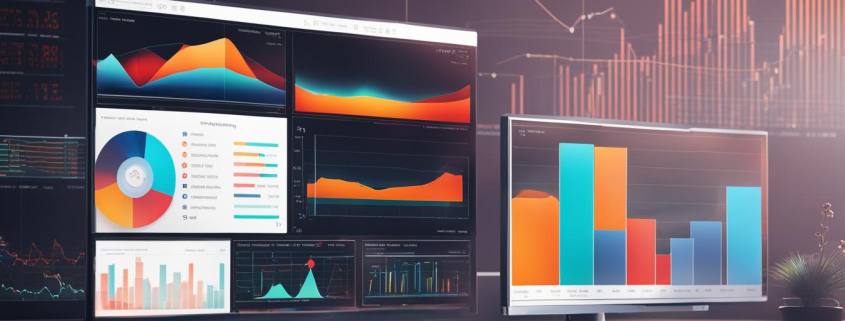Understanding the Basics: What is Monitoring Explained
Welcome to our comprehensive guide on IT monitoring. In this article, we will delve into the fundamentals of IT monitoring and its essential role in ensuring the smooth functioning of an organization’s IT infrastructure. From understanding the basics to exploring different types of IT monitoring tools, we will provide you with valuable insights to help you navigate this critical aspect of modern business operations.
Key Takeaways:
- IT monitoring refers to the products and processes used to ensure the proper functioning of an organization’s IT equipment and services.
- It has become increasingly important due to the complexity of IT environments and the rise of cloud computing.
- By monitoring IT systems in real-time, organizations can minimize downtime and prevent disruptions.
- There are different types of IT monitoring, including infrastructure monitoring, network monitoring, server monitoring, and more.
- IT monitoring plays a crucial role in IT management, DevOps practices, and automation.
The Different Types of IT Monitoring
When it comes to ensuring the smooth operation of an organization’s IT infrastructure, there are several types of IT monitoring that play a critical role. Let’s take a closer look at each type:
1. IT Infrastructure Monitoring
IT infrastructure monitoring focuses on monitoring the overall health and performance of an organization’s IT infrastructure. This includes monitoring networks, servers, storage systems, and other critical components to detect potential issues or bottlenecks. By closely monitoring the entire infrastructure, organizations can proactively address any problems before they escalate and impact the overall performance of their systems.
2. Network Monitoring
Network monitoring involves monitoring the network traffic, bandwidth usage, and overall network performance. It helps organizations identify potential bottlenecks, security threats, or connectivity issues that may impact the availability and performance of their network. By keeping a close eye on the network, organizations can optimize their network performance, ensure uninterrupted connectivity, and provide a seamless experience for their users.
3. Server Monitoring
Server monitoring focuses on monitoring the performance, availability, and health of servers within an organization’s infrastructure. It includes monitoring various server metrics such as CPU usage, memory usage, disk space, and response time to detect any abnormal behavior or potential issues. By proactively monitoring servers, organizations can ensure optimal server performance, detect and resolve any server-related problems promptly, and minimize downtime.
4. Application Monitoring
Application monitoring involves monitoring the performance and availability of applications used within an organization. It includes monitoring various application metrics such as response time, throughput, error rates, and resource usage. By closely monitoring applications, organizations can identify and address any performance issues, bottlenecks, or errors that may impact the user experience or business operations.
These are just a few examples of the different types of IT monitoring that organizations can implement to ensure the smooth operation of their IT infrastructure. By implementing a comprehensive monitoring strategy, organizations can proactively detect and address any issues, minimize downtime, and optimize the overall performance of their systems.
A Comparison of the Different Types of IT Monitoring
| Type of IT Monitoring | Focus | Main Metrics | Key Benefits |
|---|---|---|---|
| IT Infrastructure Monitoring | Overall health and performance of IT infrastructure | Network availability, server performance, storage utilization | Proactive issue detection, minimizing downtime |
| Network Monitoring | Network performance and connectivity | Bandwidth usage, network latency, security threats | Optimized network performance, uninterrupted connectivity |
| Server Monitoring | Server performance and availability | CPU usage, memory usage, disk space | Optimal server performance, minimized downtime |
| Application Monitoring | Application performance and availability | Response time, throughput, error rates | Improved user experience, optimized business operations |
Exploring IT Monitoring Tools
When it comes to IT monitoring, organizations have a wide range of tools at their disposal to ensure the optimal performance of their IT infrastructure. These tools can be categorized into three types based on their functionalities: IT infrastructure monitoring tools, observational tools, and analysis tools.
IT Infrastructure Monitoring Tools
IT infrastructure monitoring tools are designed to provide comprehensive visibility into an organization’s entire IT environment, including servers, networks, databases, and applications. These tools collect data from various sources, such as log files, device metrics, and network traffic, to monitor the health and performance of the infrastructure. They provide real-time insights, alerts, and reports, enabling IT teams to proactively identify and resolve issues before they impact the business.
Observational Tools
Observational tools play a crucial role in IT monitoring by continuously collecting data from various sources and systems. These tools capture metrics, events, and logs to provide a holistic view of the IT environment. They help identify trends, patterns, and anomalies, allowing IT teams to gain valuable insights into the performance and behavior of their systems. Observational tools are particularly useful for troubleshooting complex issues and understanding the impact of changes on the IT infrastructure.
Analysis Tools
Analysis tools are designed to make sense of the vast amount of data collected by IT monitoring systems. These tools utilize advanced algorithms and machine learning techniques to analyze the data, identify correlations, and generate actionable insights. They can help IT teams understand the root causes of issues, predict future trends, and optimize the performance of the IT infrastructure. Analysis tools empower organizations to make data-driven decisions and continuously improve their IT operations.
Engagement tools are another category of IT monitoring tools that focus on facilitating collaboration and communication among IT teams. These tools provide a centralized platform for tracking and managing incidents, assigning tasks, and sharing information. They help streamline workflow, improve productivity, and ensure effective coordination between different teams and stakeholders.
In summary, IT monitoring tools are essential for organizations to ensure the optimal performance of their IT infrastructure. These tools provide real-time insights into the health and performance of systems, enabling proactive issue resolution and minimizing downtime. By utilizing a combination of IT infrastructure monitoring tools, observational tools, analysis tools, and engagement tools, organizations can effectively monitor and manage their IT environment, ensuring smooth operations and delivering high-quality services to their users.
The Role of IT Monitoring in IT Management
IT monitoring plays a crucial role in effective IT management. By continuously monitoring the health and availability of IT infrastructure, organizations can proactively identify and resolve issues, ensuring the smooth operation of their networks, systems, and devices.
With IT monitoring, we gain essential insights into the performance of our IT systems. Real-time monitoring allows us to detect any anomalies or potential problems before they escalate, minimizing downtime and preventing costly disruptions. By monitoring key metrics such as network traffic, server response times, and application performance, we can identify bottlenecks, optimize resource allocation, and improve overall system efficiency.
Furthermore, IT monitoring provides the data and information needed for informed decision-making. By analyzing historical performance data and trends, we can identify patterns and make data-driven decisions to optimize our IT infrastructure. Whether it’s capacity planning, infrastructure upgrades, or security enhancements, IT monitoring empowers us with actionable insights to drive proactive and strategic IT management.
Benefits of IT Monitoring in IT Management
- Proactive issue detection and resolution
- Minimization of downtime and disruptions
- Optimization of resource allocation
- Data-driven decision-making
- Improved system efficiency and performance
By monitoring the health and availability of our IT infrastructure, organizations can effectively manage their networks, systems, and devices, both in the short and long term.
IT monitoring is not only about detecting and resolving issues; it is also about maintaining the overall health and performance of our IT environment. By leveraging the insights provided by IT monitoring tools, we can ensure that we are delivering high-quality services to our users, maximizing productivity, and driving business success.
| IT Monitoring in IT Management | Benefits |
|---|---|
| Proactive issue detection and resolution | Minimizes downtime and disruptions |
| Optimization of resource allocation | Maximizes system efficiency and performance |
| Data-driven decision-making | Enables informed and strategic IT management |
As IT professionals, it is crucial that we embrace the role of IT monitoring in IT management. By utilizing the right monitoring tools and practices, we can stay ahead of potential issues, ensure the stability and performance of our IT systems, and effectively meet the needs of our organization and its users.
The Synergy Between IT Monitoring and DevOps
IT monitoring plays a crucial role in the DevOps methodology, which emphasizes collaboration between development and operations teams. The frequent updates and fast-paced development cycle of DevOps require real-time monitoring to ensure the stability and performance of critical systems.
By implementing IT monitoring in a DevOps environment, organizations can proactively identify issues, detect bottlenecks, and optimize system performance. Real-time monitoring provides valuable insights into the health and availability of applications, infrastructure, and services, enabling DevOps teams to quickly identify and address any potential roadblocks.
Additionally, IT monitoring enables DevOps teams to track key performance indicators (KPIs) and monitor service level agreements (SLAs). This allows organizations to meet their business objectives by ensuring the availability and performance of their IT systems. With comprehensive monitoring in place, DevOps teams can make data-driven decisions and continuously improve the software delivery process.
Maximizing Efficiency and Collaboration with IT Monitoring
IT monitoring promotes efficiency and collaboration within DevOps teams. By having access to real-time performance data, developers and operations personnel can work together to identify and resolve issues faster. Monitoring tools provide visibility into application performance, system health, and resource utilization, allowing teams to optimize their workflows and ensure seamless deployments.
“Real-time monitoring provides valuable insights into the health and availability of applications, infrastructure, and services, enabling DevOps teams to quickly identify and address any potential roadblocks.”
Furthermore, IT monitoring facilitates communication and alignment between development and operations teams. It creates a shared understanding of system behavior, allowing teams to proactively address potential issues before they impact the user experience. By fostering collaboration and promoting a culture of shared responsibility, organizations can streamline their development and operations processes, ultimately achieving faster and more reliable software releases.
Summary
IT monitoring is a critical component of DevOps, enabling organizations to ensure the stability, availability, and performance of their IT systems. By implementing real-time monitoring and leveraging performance data, DevOps teams can proactively address issues, optimize workflows, and deliver high-quality software. Effective IT monitoring promotes collaboration, efficiency, and continuous improvement within DevOps teams, helping organizations achieve their business goals.
IT Monitoring vs. Observability: Understanding the Difference
In the realm of DevOps, IT monitoring and observability are two closely related practices that play a significant role in ensuring the stability and performance of IT systems. While they share similarities, it’s essential to understand the differences between these two concepts.
IT monitoring, as we’ve discussed earlier, focuses on collecting data on system operations and performance. It provides organizations with valuable insights into the current state of their IT systems, enabling them to identify issues and take proactive measures to resolve them. Monitoring tools track various metrics, such as CPU usage, memory utilization, network latency, and application response times, allowing teams to ensure optimal system performance.
On the other hand, observability takes a more holistic approach by emphasizing the ability to understand how systems behave from an external perspective. It goes beyond monitoring individual metrics and focuses on correlating different data points to gain a comprehensive view of system behavior. Observability aims to uncover the root causes of anomalies and failures by analyzing logs, traces, and metrics in combination with each other.
While IT monitoring provides organizations with essential real-time insights, observability enables teams to dig deeper into complex systems, helping them understand the relationships between different components and how they affect each other. By embracing observability practices, organizations can gain a higher level of visibility and a better understanding of the inner workings of their IT infrastructure.
| IT Monitoring | Observability |
|---|---|
| Focuses on collecting data on system operations and performance | Emphasizes understanding system behavior from an external perspective |
| Tracks metrics such as CPU usage, memory utilization, network latency, and application response times | Analyzes logs, traces, and metrics to uncover the root causes of anomalies and failures |
| Provides real-time insights into the current state of IT systems | Enables teams to gain a comprehensive view of system behavior and relationships between components |
In summary, IT monitoring and observability are two complementary practices that organizations should incorporate into their DevOps processes. By adopting both approaches, organizations can proactively monitor system performance while gaining a deeper understanding of how their IT infrastructure functions as a whole.
The Role of Automation in IT Monitoring
Automation plays a significant role in IT monitoring, enabling organizations to streamline processes and respond quickly to incidents. By automating repetitive tasks, IT teams can focus on more strategic initiatives, increasing efficiency and productivity. Automated IT monitoring tools can generate alerts, execute predefined actions, and even run diagnostics to troubleshoot issues without human intervention.
One of the key benefits of automation in IT monitoring is the ability to proactively detect and resolve issues before they impact system performance. With real-time monitoring and automated alerting, IT teams can identify anomalies or potential problems and take immediate action. This proactive approach helps minimize downtime and prevent costly disruptions, ensuring smooth operations.
Another advantage of automation in IT monitoring is its ability to handle large volumes of data and perform complex analyses rapidly. By leveraging artificial intelligence and machine learning algorithms, automated tools can identify patterns, detect anomalies, and provide valuable insights into system performance. This enables IT teams to make data-driven decisions, optimize resources, and improve overall system efficiency.
Benefits of Automation in IT Monitoring:
- Increased efficiency and productivity
- Proactive issue detection and resolution
- Minimized downtime and disruptions
- Rapid data analysis and insights
- Streamlined processes and optimized resource allocation
In conclusion, automation is a crucial component of IT monitoring, empowering organizations to effectively monitor and manage their IT infrastructure. By automating routine tasks and leveraging advanced analytics, organizations can enhance the performance, reliability, and security of their systems. As technology continues to evolve, automation in IT monitoring will play an increasingly vital role in enabling organizations to stay ahead in today’s rapidly changing digital landscape.
Choosing the Right IT Monitoring Software
When it comes to selecting the right IT monitoring software, organizations have a wide range of options to choose from. The right choice depends on the specific needs and requirements of each organization. Here are some key types of IT monitoring software to consider:
IT Infrastructure Monitoring Tools
IT infrastructure monitoring tools offer a benchmark for ideal systems operation and assist in fine-tuning and reducing downtime. These tools provide real-time visibility into the health and performance of servers, networks, storage, and other critical infrastructure components.
Cloud Monitoring Tools
As more organizations adopt cloud computing, cloud monitoring tools have become essential. These tools offer visibility into cloud infrastructure metrics, such as CPU, memory, and storage usage. They enable organizations to monitor the health and performance of their cloud-based applications and services.
Application Performance Monitoring (APM) Tools
APM tools gather software performance metrics and enable end-to-end monitoring of customer-facing applications. They help organizations identify and troubleshoot performance bottlenecks, ensuring optimal application performance and user satisfaction.
Log Monitoring Tools
Log monitoring tools analyze and monitor logs for security and performance purposes. They provide organizations with insights into system activities, errors, and potential security threats. By monitoring logs, organizations can proactively detect and remediate issues, improving system reliability and security.
Network Security Monitoring Tools
Network security monitoring tools focus on detecting and preventing intrusions at the network level. They provide real-time visibility into network traffic and help organizations identify and respond to security incidents promptly. These tools play a critical role in maintaining the integrity and security of IT infrastructure.
| IT Monitoring Software | Main Features |
|---|---|
| IT Infrastructure Monitoring Tools | Real-time visibility into critical infrastructure components |
| Cloud Monitoring Tools | Monitoring of cloud infrastructure metrics |
| APM Tools | End-to-end monitoring of customer-facing applications |
| Log Monitoring Tools | Analysis and monitoring of logs for security and performance |
| Network Security Monitoring Tools | Detection and prevention of network-level intrusions |
Choosing the right IT monitoring software is crucial for organizations to effectively monitor their IT infrastructure, detect and resolve issues, and ensure optimal system performance. By considering their specific monitoring needs and requirements, organizations can select the software that best aligns with their goals and objectives.
Conclusion
IT monitoring plays a vital role in ensuring the efficient functioning of an organization’s IT infrastructure. By monitoring hardware, software, and services, organizations can proactively detect and resolve issues, minimize downtime, and improve overall system performance. This enables us to provide uninterrupted services to our users, ensuring their satisfaction and trust in our brand.
IT monitoring is closely intertwined with IT management, DevOps practices, and automation. It provides essential information for us to make informed decisions and effectively manage our networks, systems, and devices. By adopting DevOps methodologies and leveraging real-time monitoring, we can achieve seamless operations and meet the ever-increasing demands of our customers.
Choosing the right IT monitoring software is crucial to meet our specific monitoring needs and requirements. Whether it’s IT infrastructure monitoring tools, cloud monitoring tools, application performance monitoring (APM) tools, log monitoring tools, or network security monitoring tools, we must carefully evaluate and select the solution that best aligns with our organizational goals and objectives.
Ultimately, IT monitoring empowers us to stay ahead of potential issues, optimize system performance, and deliver high-quality services. By investing in the right monitoring tools and practices, we can ensure the reliability and resilience of our IT infrastructure, enabling us to focus on our core business activities and drive success in today’s digitally-driven landscape.
FAQ
What is IT monitoring?
IT monitoring refers to the products and processes used to ensure that an organization’s IT equipment and services are functioning properly and to detect and resolve any problems that may arise.
Why is IT monitoring important?
IT monitoring has become increasingly important in recent years due to the growing complexity of IT environments, especially with the rise of cloud computing. It helps organizations minimize downtime and prevent costly disruptions by monitoring IT systems in real-time.
What are the types of IT monitoring?
There are several types of IT monitoring that organizations can implement, including IT infrastructure monitoring, network monitoring, server monitoring, application monitoring, performance monitoring, and system monitoring.
How does IT monitoring relate to IT management?
IT monitoring provides essential information for IT teams to understand the performance of their systems and make informed decisions. By monitoring the health and availability of IT infrastructure, organizations can effectively manage their networks, systems, and devices.
What is the role of IT monitoring in DevOps?
IT monitoring plays a crucial role in the DevOps methodology, which emphasizes collaboration between development and operations teams. It ensures the stability and performance of critical systems in the fast-paced development cycle of DevOps.
What is the difference between IT monitoring and observability?
IT monitoring focuses on collecting data on system operations and performance, providing insight into the current state of IT systems. Observability, on the other hand, is a broader practice that encompasses monitoring but also emphasizes the ability to understand why and how systems are behaving.
How does automation contribute to IT monitoring?
Automation plays a significant role in IT monitoring by streamlining processes and enabling organizations to respond quickly to incidents. It can automate tasks such as generating alerts, executing predefined actions, or running diagnostics to troubleshoot issues without human intervention.
How do I choose the right IT monitoring software?
When selecting IT monitoring software, organizations should consider their specific needs and requirements. There are various types of monitoring tools available, including IT infrastructure monitoring tools, cloud monitoring tools, application performance monitoring (APM) tools, log monitoring tools, and network security monitoring tools.
- About the Author
- Latest Posts
Mark is a senior IT technician at Biteno.com . He writes about Linux, Windows and Software.









